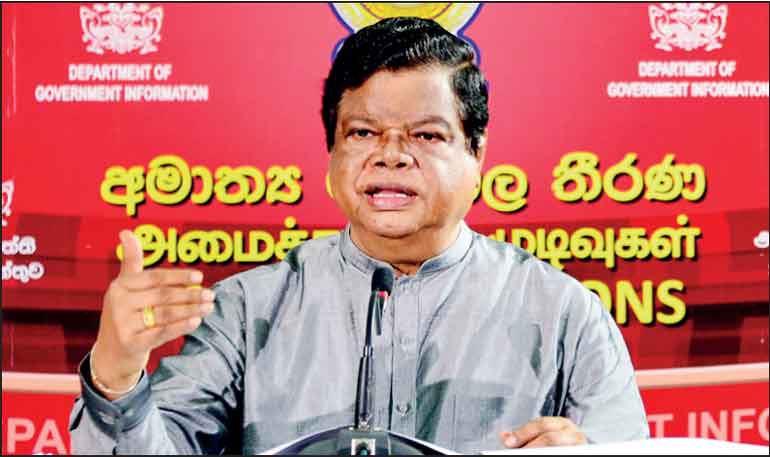Sunday Apr 20, 2025
Sunday Apr 20, 2025
Wednesday, 12 October 2022 00:35 - - {{hitsCtrl.values.hits}}

Cabinet Co-Spokesman and Minister Bandula Gunawardena at the media briefing
By Charumini de Silva
Confusion reigned yesterday over Sri Lanka’s status in the world after the Cabinet backed a move to reclassify the country as “low income” whilst the President’s Media Office said the nation will remain “middle income.”
“Sri Lanka will remain a middle-income country despite a decision taken by the Cabinet of Ministers on Monday, the President’s Media Division said.
The PMD notification came minutes after Cabinet Co-Spokesman and Minister Bandula Gunawardena announced the weekly Cabinet decisions at the Government Information Department.
Issuing a statement, the President’s Media Division said the Government was only pursuing a ‘reverse graduation’ policy for a limited period of time.
As per the Cabinet Spokesman, the Cabinet of Ministers at its meeting on Monday approved a proposal submitted by President Ranil Wickremesinghe as the Finance Minister to reclassify Sri Lanka as a ‘low-income’ country from a middle-income country.
The proposal to this effect submitted by President Ranil Wickremesinghe in his capacity as the Finance, Economic Stabilisation and National Policies Minister was approved by the Cabinet of Ministers on Monday.
Minister Gunawardena told journalists the downgrade was a reflection of the economic status of the country.
He said in a bid to draw foreign aid to prevail over the multitude of challenges amidst the ongoing economic crisis, the Government had decided to seek the World Bank to reclassify Sri Lanka from a middle-income country to a low-income country.
The move sought to obtain concessionary funding from the International Development Association (IDA) — an arm of the World Bank that helps the world’s poorest and most vulnerable countries, following the information provided by intercontinental organisations.
“Decision was taken after considering the financial constraints to obtain concessionary loans, lack of foreign reserves, and descending income,” Minister Gunawardena said at the post-Cabinet meeting media briefing yesterday.
He said post-independence, Sri Lanka’s per capita income was at $ 120 and it took 56 years for the country to reach $ 1,000 in 2004. However, with the dawn of peace in 2010, Sri Lanka was able to utilise one-thirds of the land and two-thirds of the coast, leading to massive economic development and industrialisation, which contributed to increase the GDP per capita to $ 3,827 upgrading to a middle-income country, he added.
“In 2017, our GDP per capita had risen to $ 4,074, but decreased in the following years to $ 4,057 in 2018, $ 3,848 in 2019, $ 3,695 in 2020 and $ 3,815 in 2021, and is expected to decrease further with the 2022 economic crisis. Hence, the Government decided to seek a ‘reverse graduation’ from the World Bank,” Gunawardena explained.
The World Bank country classification is based on the per capita Gross National Income or GNI per capita calculated using its Atlas method.
Cabinet Spokesman Gunawardena asserted that the reverse graduation would only be effective once the World Bank endorsed the submission by Sri Lanka.
In 2020, Sri Lanka was downgraded as a developing/emerging lower-middle-income economy, just a year after (2019) it was elevated to the upper-middle-income category.
For the current 2023 fiscal year, low-income economies are defined as those with a GNI per capita, of $ 1,085 or less in 2021; lower-middle-income economies are those with a GNI per capita between $ 1,086 and $ 4,255; upper-middle-income economies are those with a GNI per capita between $ 4,256 and $ 13,205; and high-income economies are those with a GNI per capita of $ 13,205 or more.

Discover Kapruka, the leading online shopping platform in Sri Lanka, where you can conveniently send Gifts and Flowers to your loved ones for any event including Valentine ’s Day. Explore a wide range of popular Shopping Categories on Kapruka, including Toys, Groceries, Electronics, Birthday Cakes, Fruits, Chocolates, Flower Bouquets, Clothing, Watches, Lingerie, Gift Sets and Jewellery. Also if you’re interested in selling with Kapruka, Partner Central by Kapruka is the best solution to start with. Moreover, through Kapruka Global Shop, you can also enjoy the convenience of purchasing products from renowned platforms like Amazon and eBay and have them delivered to Sri Lanka.
Discover Kapruka, the leading online shopping platform in Sri Lanka, where you can conveniently send Gifts and Flowers to your loved ones for any event including Valentine ’s Day. Explore a wide range of popular Shopping Categories on Kapruka, including Toys, Groceries, Electronics, Birthday Cakes, Fruits, Chocolates, Flower Bouquets, Clothing, Watches, Lingerie, Gift Sets and Jewellery. Also if you’re interested in selling with Kapruka, Partner Central by Kapruka is the best solution to start with. Moreover, through Kapruka Global Shop, you can also enjoy the convenience of purchasing products from renowned platforms like Amazon and eBay and have them delivered to Sri Lanka.